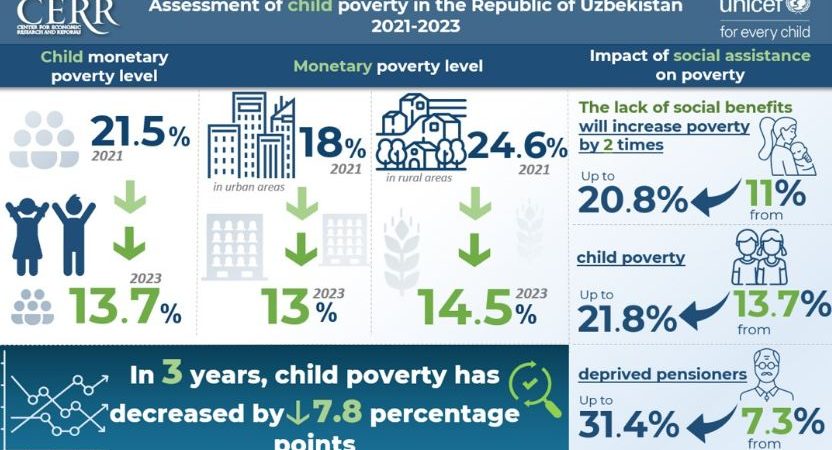Assessment of Child Poverty in the Republic of Uzbekistan

Center for Economic Research and Reforms (CERR), together with UNICEF, assessed the level of monetary child poverty in Uzbekistan. The study analyzed the impact of the social protection system on the poverty level. According to the calculations, in the absence of social payments, the child poverty rate in the country would have increased by 1.6 times.
April 1, 2024.The Center for Economic Research and Reforms (CERR), together with the United Nations Children’s Fund (UNICEF) in Uzbekistan, conducted an assessment of the level of poverty among the child population, as well as an analysis of the effectiveness of the social protection system.
The child poverty rate was calculated based on data from a Household Budget Survey data collected by the Statistics Agency in collaboration with the World Bank.
While 10,000 households were surveyed in 2021, more than 16,000 households were surveyed across the country in 2023.
Over the past three years, child poverty in Uzbekistan has decreased by 7.8 percentage points.
According to the results, the child poverty rate decreased from 21.5% in 2021 to 13.7% in 2023.
Poverty reduction trends vary markedly between urban and rural areas. In particular, in rural areas, the child poverty rate decreased from 24.6% to 14.5%, while in urban areas it decreased from 18% to 13%.
The study found that the regions with the lowest level of child poverty are Navoi region and Tashkent city, while a relatively high level of child poverty is observed in Syrdarya and Jizzakh regions.
Social benefits analysis
According to the National Agency of Social Protection, the total coverage of social benefits in Uzbekistan in 2023 amounted to 10.8 million people.
The coverage of low-income families with child benefits and financial aid amounted to 9 million people from 2.1 million low-income families and 72.5 thousand beneficiary families, with a total amount of payments of 12.3 trillion sums.
In order to increase the efficiency of investments in the social protection system, as well as the effectiveness and reforms, the CERR analyzed the distribution of social benefits among various groups of households.
The effectiveness and targeting of the social protection system was assessed by analyzing the distribution, coverage, and adequacy of social benefits, as well as their impact on the poverty level.
Experts note that the existing social protection system directs most of its resources to the least affluent segments of the population. However, according to the calculations, almost 6% of those receiving social assistance belong to the 20% most affluent households, including 4% of households receiving child benefits.
In contrast, old-age pensions are distributed relatively evenly among all population groups, reflecting a universal approach to ensuring the well-being of the elderly population.
Impact of social assistance on poverty level
The study analyzed the impact of the social protection system on the poverty level.
That way, in case of insufficient income, when incomes are below the poverty line, the absence of social payments would increase the poverty rate from 11% to 20.8%, child poverty from 13.7% to 21.8% and the share of deprived pensioners from 7.3% to 31.4%.
Overall, this analysis allows us to assess the effectiveness and targeting of the social protection system, identify its advantages and disadvantages, and propose measures for its improvement in order to ensure more equal access to social benefits and reduce the poverty level in society.
Hereby, Uzbekistan demonstrates its commitment to achieving the SDG 1 – to end poverty in all its forms by 2030. In this regard, measuring monetary child poverty is a significant step towards achieving this mission.
Related News

Future of Digital Banking in Pakistan: Ali Jahangir Siddiqui’s perspective
Ali Jahangir Siddiqui, a leading entrepreneur and former ambassador, is driving Pakistan’s digital banking transformationRead More

A Grim Diagnosis
By Amal Kamal Imagine a ship caught in a storm—its sail tattered as waves crashRead More


Comments are Closed